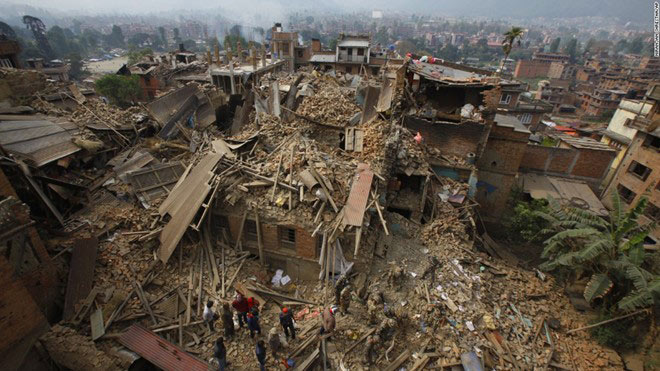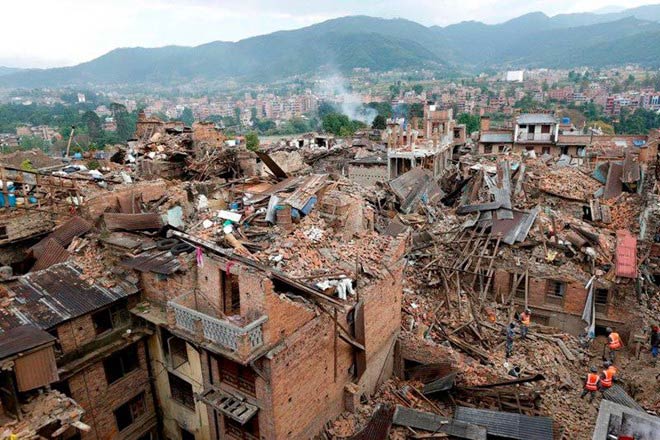Lessons from the earthquake in Nepal
Safe infrastructure and disaster response capacity are valuable lessons that Nepal and other countries need to withdraw after the disaster in South Asia.
Nepal - Lessons from disaster

Kathmandu fell after the magnitude 7.9 earthquake.(Photo: CNN)
According to Diplomat, Nepal is one of the least developed countries in the world, per capita GDP is about 649 USD per year. This figure is even lower than that of Mali and Burkina Faso (2 African countries that rely on foreign aid).
The unemployment rate in Nepal is up to 40%. South Asia's national income depends heavily on foreign workers. Overseas remittances account for one-third of economic activity. In 2008, a specialized 240-year monarchy was abolished after a decade of struggle from the Maoist rebellion.
Political instability has undermined local and government efforts, including those responsible for preparing for earthquakes. As a result of the political event, Nepal suffered heavy losses after the earthquake disaster on April 25.
In an interview with Cosmos magazine, Paul Tapponnier, a French geologist, said: "The place I am worried about is the earthquake center of Nepal."
The average age of people is about 22.9, more than half of the population is younger than 24 years. A recent study showed that people with experiences in Nepal earthquakes were more worried about damage than those born after the 1988 disaster.
That difference shows the importance of awareness in preparing to deal with natural disasters. Good infrastructure helps to increase resilience quickly after disaster, but awareness of information and behavior at the individual and government level is extremely important.
Infrastructure key

Underdeveloped infrastructure is the main reason for Nepal's heavy losses after the disaster.(Photo: Business Insider)
The disaster in Nepal is a wake-up call to show the need to ensure good infrastructure and long-term policy planning for disaster prevention. In Kathmandu, where geological conditions are unstable, and the density of construction is dense but of poor quality, creating an extremely dangerous living environment.
According to Demographia, Kathmandu is the 33rd most densely populated city in the world, while urban planning is weak. In 2012, the chief engineer of Nepal Urban Development and Construction admitted that the buildings were built without adherence to the plan.
95% of government offices violate construction laws. With poor construction conditions, high population density, future earthquakes in Nepal will have very serious consequences. If the recent earthquake occurred at night or on the day the student arrived, the number of deaths would be many times higher.
Construction laws in Nepal took effect more than two decades ago, however, the implementation of the law was very lax. Thousands of illegally built houses in the last 20 years create poor quality infrastructure. So everything almost collapsed completely when an earthquake struck.
The US Geological Survey estimated that economic losses after the disaster could exceed Nepal's annual GDP (about $ 20 billion). It is not known whether earthquakes affect hydroelectric dams, but it will exacerbate the problem of electric crisis in this country.
The earthquake may delay the construction of a $ 1.6 billion hydroelectric dam funded by China. The feasibility of a large hydroelectric dam in an unstable geological area is a matter of reconsideration. Thus, the problem of electricity shortage will hinder efforts to overcome consequences and economic development.
Infrastructure quality is an important determinant of resilience after disaster. According to data from the Global Adaptation Index, University of Notre Dame (USA), Nepal ranks 55th out of 132 countries in terms of vulnerability to natural disasters.
Ability to cope

The poor ability of government response was criticized as the cause of the high death toll.(Photo: Financialexpress)
In addition to infrastructure issues, the ability to deal with disasters is an extremely important factor. Disaster response organizations must be competent at the national and local levels to respond immediately when disaster strikes. They must be able to predict disaster in order to prepare.
Countries such as China, India, Indonesia and Turkey are seeking to prevent and respond to difficulties in accessing restricted traffic areas in mountainous areas, where earthquakes often occur.
Nepal and other developing countries can draw valuable lessons from a new disaster.Newly built buildings must be able to withstand shocks to a certain extent. Besides, the government needs to strictly dismantle illegal construction works.
Essential public works such as hospitals, schools, police stations must be built according to high safety standards with earthquakes similar to those in Japan and New Zealand. In addition to improving infrastructure, the Nepalese government and donors need to improve their capacity to cope with natural disasters in this country.
Based on post-disaster experience in developing countries, there is little reason to be optimistic that Nepal can be renewed. Some improvements may be made but not all are effective. The generosity of the world is heading towards Nepal but when the world media turns their attention to other issues, Nepal will return to the grim reality of everyday life.
Poor infrastructure, political instability, corruption, ineffective policies can put an end to the problem of improving the problem.Countries should look at the disaster in Nepal to eliminate outdated policies.
"Nepal is having the opportunity to start economic growth through building high quality infrastructure and improving disaster response capacity. This could be the last chance to change," said Asit K. Biswas, visiting professor of Lee Kuan Yew University, Singapore, said.
- The earth 'stirred' under the influence of the earthquake in Nepal
- The valley in Nepal is 80 cm tall after the earthquake
- Nepal is about to suffer a Haiti-like earthquake
- Mount Everest moved after Nepal earthquake
- 1,000 missing Europeans in Nepal after the earthquake
- Four new earthquake quakes shook Nepal
- Why is Nepal continuing to suffer from earthquakes?
- Use debris from Nepal earthquake to build a house
- Nearly 2,500 people died of earthquake, Nepal chaos
- The Richter 7.3-degree earthquake shook Nepal
- More than 5,000 people died from earthquakes, Nepalese people resented rescue
- Nepal still shook because of aftershocks, after a month of earthquakes
 Is the magnetic North Pole shift dangerous to humanity?
Is the magnetic North Pole shift dangerous to humanity? Washington legalizes the recycling of human bodies into fertilizer
Washington legalizes the recycling of human bodies into fertilizer Lightning stone - the mysterious guest
Lightning stone - the mysterious guest Stunned by the mysterious sunset, strange appearance
Stunned by the mysterious sunset, strange appearance